When a movie blows us away or a web series hooks us from the first episode, we often instinctively credit the director for their vision or the lead actors for their captivating performances. And rightly so—their contributions are undeniable and vital. But what if we told you that the magic you see on screen is less the work of a single genius and more the symphony of hundreds, sometimes thousands, of skilled individuals?
Filmmaking is perhaps the ultimate collaborative art form. It’s a complex dance where every department plays a crucial role in transforming a script into a living, breathing world. While the stars shine brightly and the director’s name often tops the posters, countless other professionals work tirelessly behind the scenes, their artistry meticulously woven into every frame, every sound, and every emotion you experience.
At plotwit, we want to pull back the curtain and introduce you to some of these indispensable, yet often unseen, artisans. This post will celebrate 7 unsung heroes of film and television—the craftspeople whose dedication, creativity, and technical prowess are absolutely essential to bringing your favorite stories to life. Get ready to watch your next binge-watch with a whole new level of appreciation.
The Architects of Illusion – Unsung Heroes Revealed
1. The Editor: The Ultimate Story Shaper
When a director shouts “Cut!” the actual filmmaking process is far from over. In many ways, it’s just beginning for the Editor. Often referred to as the “final writer” or “second director,” the editor is the artisan responsible for assembling raw footage, sound, and visual effects into a cohesive, engaging, and emotionally resonant narrative. They choose which takes to use, how long each shot lasts, and how scenes flow into one another.
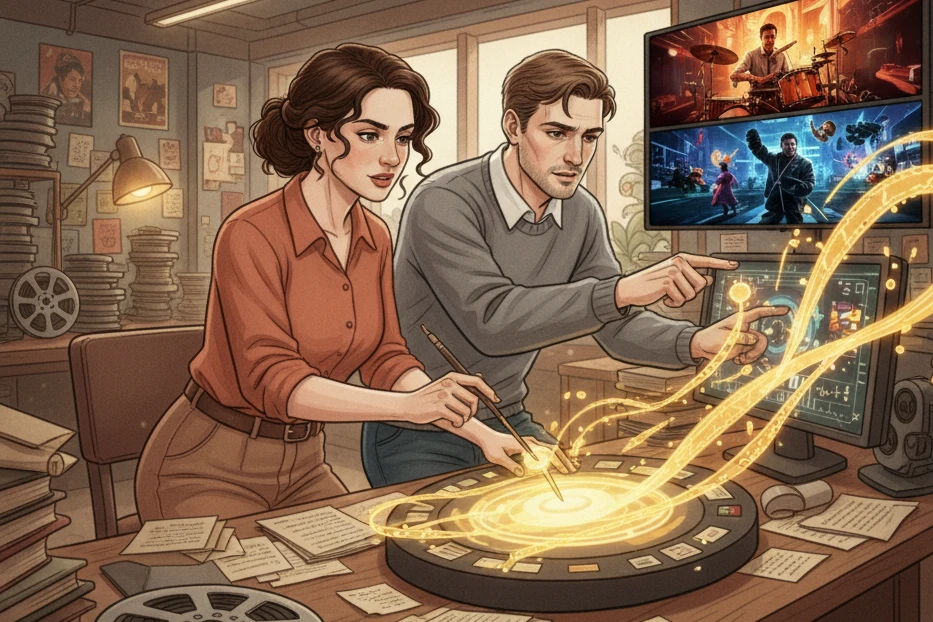
What They Do:
An editor’s job is a delicate balance of technical skill and artistic intuition. They receive mountains of raw footage – often hundreds of hours for a feature film – and meticulously piece it together. This involves:
- Selecting the Best Takes: Identifying the most powerful performances and visually impactful shots.
- Pacing and Rhythm: Dictating the speed and flow of the story. A fast-paced action sequence, a lingering emotional moment, or a sudden jump scare are all carefully constructed by the editor.
- Building Tension: Through cuts, pauses, and the juxtaposition of images, they manipulate audience emotions, building suspense or surprise.
- Managing Continuity: Ensuring that the visual and narrative flow is seamless, even if shots were filmed weeks apart in different locations.
- “Rewriting” the Film: Sometimes, scenes that don’t work in script form find new life, or even a new meaning, in the editing room. An editor can salvage a struggling narrative or elevate an already good one to greatness.
Why They’re Essential:
Without skilled editing, even the most beautifully shot and acted film would be a chaotic, incomprehensible mess. Editors are the invisible hand guiding your emotional journey, ensuring that every beat lands, every laugh is earned, and every tear feels real. They determine what the audience sees and when, shaping our entire perception of the story.
Hero Highlight:
Think of the relentless tension in Whiplash (2014), where rapid-fire cuts and precise rhythm perfectly mirror the escalating intensity of the music and the characters’ conflict. Or consider the intricate, multi-layered storytelling in Everything Everywhere All At Once (2022), where the editors masterfully weave together disparate universes and emotional timelines into a coherent, exhilarating whole.
2. The Production Designer: The World Creator
Before a single actor steps onto set, before the cameras even roll, someone has to dream up and build the world of the story. That person is the Production Designer. This hero is responsible for the overall visual aesthetic of a film or TV show – literally everything you see on screen that isn’t an actor or a natural landscape.
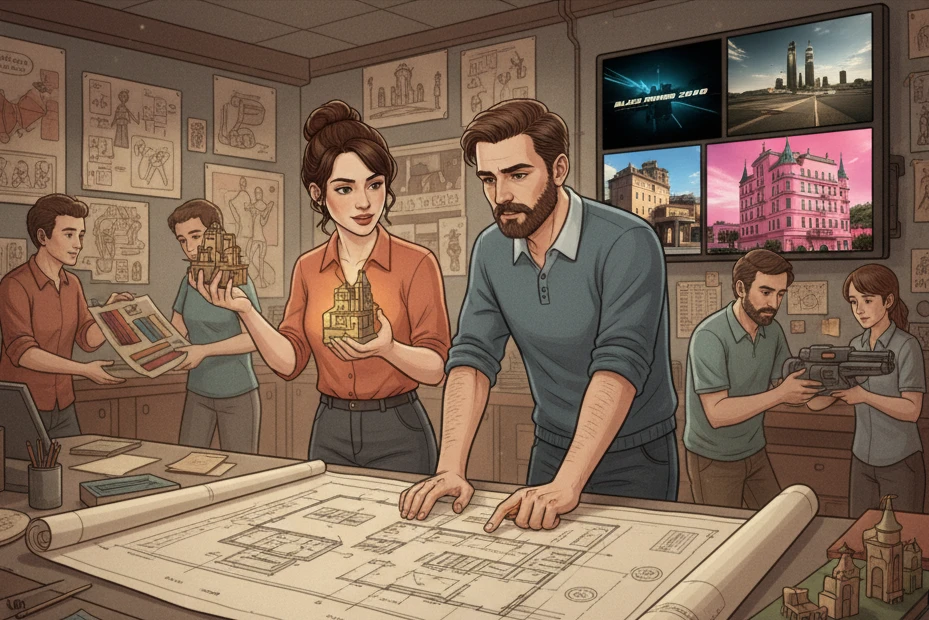
What They Do:
The Production Designer is a visionary artist and an organizational wizard. Their responsibilities include:
- Conceptualizing the Look: Working closely with the director, they translate the script’s abstract ideas into concrete visual elements.
- Designing Sets: From sprawling futuristic cities to cozy living rooms, they design every physical space. This includes architectural drawings and models.
- Overseeing Construction: Managing teams of set decorators, prop masters, and construction crews to bring their designs to life.
- Location Scouting: Collaborating to find real-world locations that fit the aesthetic and narrative needs.
- Visual Continuity: Ensuring that the sets, props, and overall environment remain consistent and authentic throughout the entire production.
Why They’re Essential:
A great Production Designer doesn’t just build pretty backdrops; they build worlds. Their work immerses the audience, helps define characters through their surroundings, and establishes the film’s tone, period, and mood. Without their meticulous attention to detail and imaginative vision, stories would lack a convincing, vibrant environment, making it impossible for us to suspend our disbelief.
Hero Highlight:
The breathtaking, desolate future of Blade Runner 2049 (2017) is a masterclass in production design, creating a world both beautiful and terrifying. Similarly, the meticulously crafted, whimsical sets of Wes Anderson’s The Grand Budapest Hotel (2014) are so distinctive they become characters in themselves. For TV, the vast, intricate kingdoms and rich cultures depicted across all seasons of Game of Thrones are a testament to monumental production design.
3. The Cinematographer / Director of Photography (DP): The Eye of the Camera
While the director guides the overall artistic vision, it is the Cinematographer, or Director of Photography (DP), who is fundamentally responsible for how that vision looks on screen. They are the chief of the camera and lighting crews, translating the director’s ideas into tangible visual language.
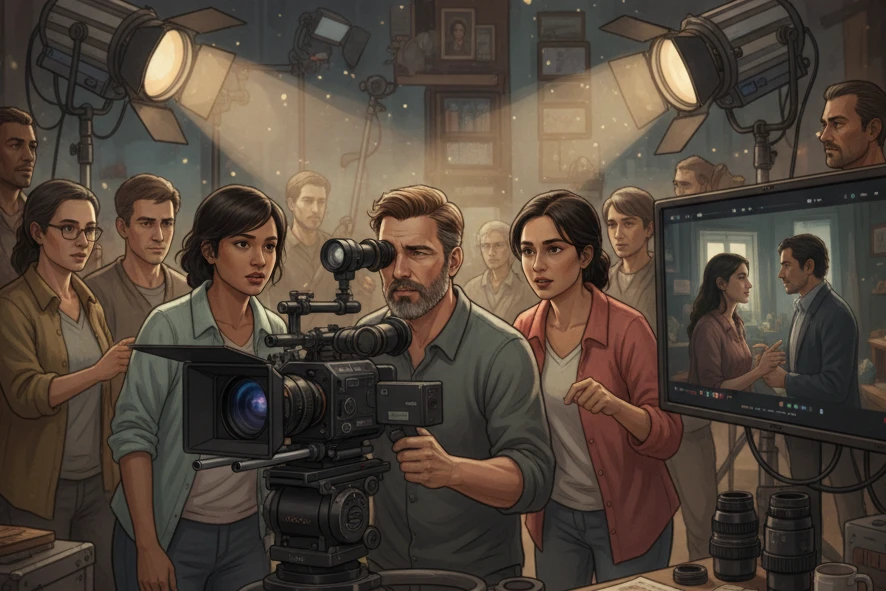
What They Do:
The DP is essentially the visual artist of the film. Their job is multifaceted:
- Shot Composition: Deciding where the camera goes, what’s in the frame, and how elements are arranged to convey meaning.
- Camera Movement: Planning how the camera moves (or doesn’t move) to enhance storytelling – from a steady tracking shot to a jarring handheld perspective.
- Lighting Design: Working with the gaffer (their lighting counterpart) to craft the mood, atmosphere, and focus of each scene using light and shadow.
- Lens Choice & Focus: Selecting lenses that create specific visual effects (e.g., wide shots for scale, telephoto for intimacy) and manipulating focus to draw the audience’s eye.
- Color Palette: Collaborating on the overall color scheme of the film, from vibrant hues to muted tones, to evoke specific emotions or themes.
Why They’re Essential:
A skilled DP doesn’t just record images; they create them. Their choices dictate what we see, how we see it, and how it makes us feel. They can make a character seem powerful or vulnerable, a setting vast or claustrophobic. Their artistry is what truly makes a film a visual medium. The quality of the cinematography is often what elevates a good story to a truly cinematic experience.
Hero Highlight:
Roger Deakins’ breathtaking work on 1917 (2019) is a prime example, creating the illusion of a single, continuous shot that plunges the audience directly into the chaos of war. Bong Joon-ho’s Parasite (2019) uses expert cinematography to highlight class distinctions and claustrophobia within its settings. On television, Euphoria (HBO) is renowned for its distinctive, bold color palettes and stylized lighting that define its visual identity.
4. The Gaffer: The Lighting Maestro
Working hand-in-hand with the Cinematographer, the Gaffer (short for “Chief Electrician”) is the unsung hero who brings the light to the scene. While the DP conceptualizes the look, the Gaffer and their team make it happen, making precise adjustments to every light on set.
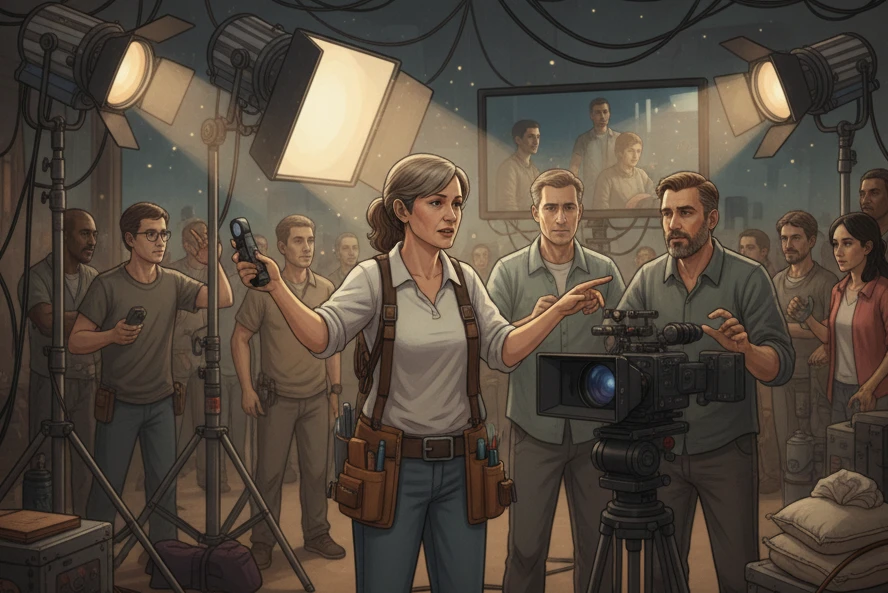
What They Do:
The Gaffer’s role is critical for executing the visual plan:
- Executing the Lighting Plan: Translating the DP’s artistic vision for lighting into a practical, safe, and efficient setup.
- Rigging and Operating Lights: Setting up all the necessary lamps, stands, cables, and power distribution on set.
- Shaping Light: Using various tools like diffusers, reflectors, flags, and gels to soften, harden, block, or colorize light.
- Troubleshooting: Solving lighting challenges on the fly, adapting to changing conditions (like outdoor light), and ensuring electrical safety.
Why They’re Essential:
Light is fundamental to how we perceive everything, and in filmmaking, it is a powerful storytelling tool. It can create drama, reveal character, highlight detail, or obscure secrets. A Gaffer ensures that every shadow and every highlight serves the narrative. They are the ones who literally “paint with light,” giving depth, texture, and mood to the DP’s compositions. Without their technical expertise and quick problem-solving, the stunning visuals conceived by the DP would remain just concepts.
Hero Highlight:
Consider the stark, moody lighting that amplifies the mystery in Prisoners (2013), or the vibrant, romantic glow that permeates La La Land (2016). In both cases, the Gaffer played a crucial role in translating the DP’s vision for these distinct atmospheres into reality, making the lighting not just functional, but deeply emotive.
5. The Costume Designer: The Character Weaver
Clothes make the man, or woman, or alien. And on screen, it’s the Costume Designer who meticulously crafts the visual identity of every character through their attire. Their work goes far beyond simply dressing actors; it’s a profound act of storytelling.
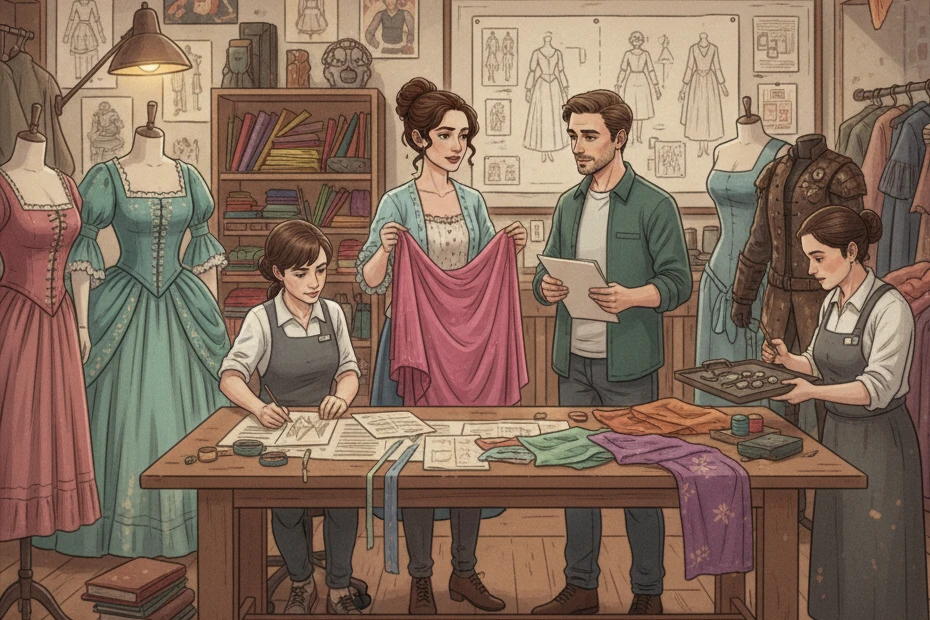
What They Do:
The Costume Designer’s process is intricate and involves both research and artistic interpretation:
- Character Interpretation: Analyzing the script to understand each character’s personality, background, social status, and arc.
- Historical Research: For period pieces, extensive research into accurate clothing, fabrics, and styles of the era.
- Design and Sourcing: Sketching designs, sourcing existing garments, or commissioning custom pieces. They also manage a team of tailors, seamstresses, and wardrobe assistants.
- Color and Fabric Choices: Selecting materials and colors that not only look good on camera but also reflect the character’s emotional state or theme of the scene.
- Aging and Weathering: Making costumes look lived-in, battle-worn, or pristine, depending on the story’s needs.
Why They’re Essential:
Costumes are silent storytellers. They immediately communicate volumes about a character before they even utter a word. A well-designed costume can define a character’s era, profession, wealth, or even their inner turmoil. It can subtly track a character’s journey of transformation or reveal hidden aspects of their personality. Without the Costume Designer, characters would feel generic and less believable, losing a crucial layer of visual depth.
Hero Highlight:
The opulent and historically resonant fashion in Marie Antoinette (2006) tells a story of excess and isolation. In contrast, the technologically advanced, culturally rich designs of Black Panther (2018) not only created iconic superhero looks but also celebrated Afrofuturistic aesthetics. Anya Taylor-Joy’s evolving wardrobe in The Queen’s Gambit (2020) isn’t just stylish; it visually charts her growth and confidence as a chess prodigy.
6. The Sound Designer / Sound Mixer: The Aural Architect
We often talk about what we see in movies, but what about what we hear? The Sound Designer (often working closely with a Sound Mixer and their team) is the unsung hero responsible for crafting the entire auditory landscape of a film or TV show. They create the soundscape that immerses us, thrills us, or breaks our hearts.
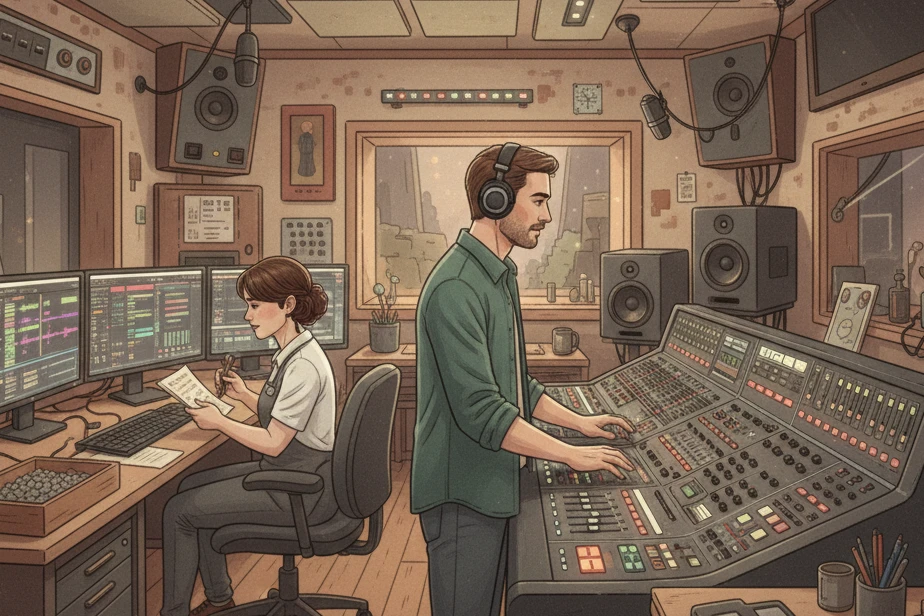
What They Do:
The Sound Designer’s role encompasses a vast array of audio elements:
- Dialogue Editing: Ensuring all spoken words are clear, consistent, and emotionally impactful.
- Sound Effects (SFX): Designing and layering specific sounds – from the subtle rustle of leaves to an exploding spaceship – to enhance realism and mood.
- Foley Artistry: Creating everyday sound effects (footsteps, clothing rustles, door creaks) in sync with the visuals, often in a studio using ingenious methods.
- Ambience/Atmosphere: Building background sounds that define a location (e.g., bustling city, quiet forest, eerie haunted house).
- Mixing: Blending all these elements – dialogue, music, and sound effects – into a seamless, balanced, and dynamic whole, ensuring they work together without clashing.
Why They’re Essential:
Sound is arguably 50% of the cinematic experience, yet it often works on a subconscious level. A great soundscape can amplify emotion, build tension, clarify action, and transport you into the world of the story in a way visuals alone cannot. A single, well-placed sound effect can be more terrifying than any visual horror, and a rich ambient track can make a setting feel alive. Without a skilled Sound Designer, films would lose depth, immersion, and much of their emotional punch.
Hero Highlight:
The masterful use of silence and jarring noise in A Quiet Place (2018) turns sound itself into a weapon and a source of unbearable tension. The visceral, overwhelming soundscape of Dunkirk (2017) plunges viewers directly into the chaos of war. Even the driving, almost improvisational drum score that becomes a character itself in Birdman (2014) is a testament to inventive sound design.
7. The First Assistant Director (1st AD): The On-Set Commander
Think of a bustling film set with hundreds of crew members, expensive equipment, tight schedules, and demanding actors. Who keeps this intricate machinery running smoothly, efficiently, and safely? That’s the First Assistant Director (1st AD). While not a creative role in the artistic sense, their organizational prowess is absolutely vital for the creative process to even happen.
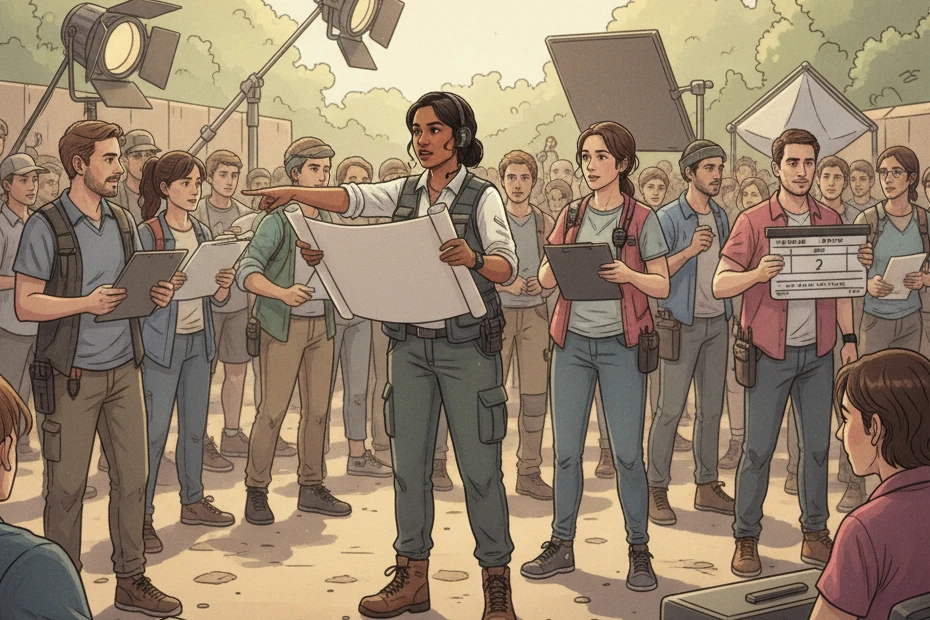
What They Do:
The 1st AD is the tactical general of the set:
- Scheduling Master: Breaking down the script into a detailed shooting schedule, factoring in locations, actors’ availability, and technical requirements.
- Logistics & Efficiency: Ensuring that everything and everyone is in the right place at the right time, minimizing costly delays.
- Crew Management: Overseeing all departments on set, coordinating their activities, and keeping them on track.
- Set Safety: Implementing and enforcing safety protocols to protect the cast and crew.
- Director’s Bridge: Acting as the primary liaison between the director and the rest of the crew, communicating the director’s needs and ensuring they are met.
- Keeping on Budget: Preventing costly overruns by ensuring shooting days are efficient and productive.
Why They’re Essential:
Without an exceptional 1st AD, a film set would descend into chaos, quickly falling behind schedule and blowing its budget. Their job is to manage the complex logistical ballet that allows the director, DP, and actors the freedom to focus purely on their creative work. They ensure that every dollar is spent wisely and every minute is used effectively, ultimately making the entire production possible. Their work is the invisible backbone that supports all the visible artistry.
Hero Highlight:
Their work is by nature subtle and behind-the-scenes, but you “feel” the presence of a great 1st AD in the seamless efficiency of any large-scale, complex production. Think of the intricate planning required for massive action sequences in a Marvel blockbuster or the demanding schedules of a long-running TV series like Game of Thrones. The smooth execution of such projects is a direct reflection of an outstanding 1st AD.
A Deeper Appreciation for Movie Magic
As we pull back the curtain on these seven unsung heroes, it becomes clear that true movie magic is rarely, if ever, the product of a single mind. It is a testament to the power of collective artistry, where hundreds of brilliant individuals collaborate, each contributing their unique skills to a shared vision.
From the editor who sculpts emotion from raw footage, to the production designer who builds entire worlds, the gaffer who paints with light, and the 1st AD who orchestrates the chaos into harmony—each role is indispensable. They are the unseen hands and minds that elevate a story from words on a page to a breathtaking, immersive experience.
The next time you settle in for your favorite movie or fire up that must-watch web series, try to look beyond the leading faces and listen past the catchy soundtrack. Think about the intricate set designs, the subtle shifts in lighting, the precise rhythm of the cuts, or the evocative layers of sound. You’ll find a whole new world of artistry unfolding before you, brought to life by the tireless dedication of these incredible, unsung heroes.
Which of these filmmaking roles surprised you most, or gained your newfound respect? Is there another behind-the-scenes hero you think deserves more recognition? Share your thoughts in the comments below – we’d love to hear from you!

